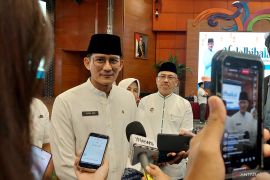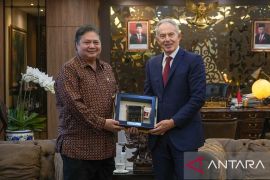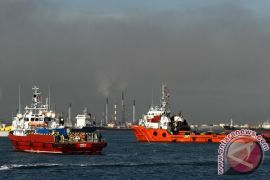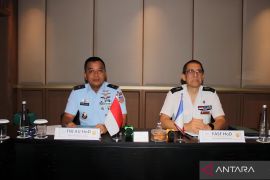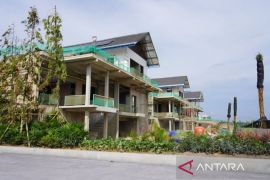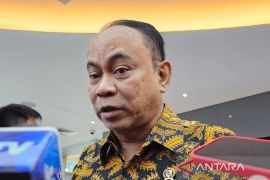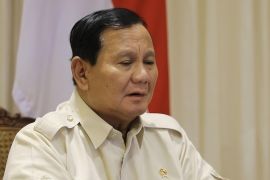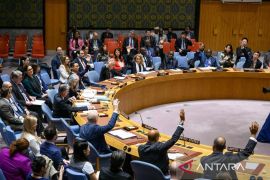"They are fighting us with advanced weapons, but we have a slingshot. They have bombs, but we have stones".Jakarta (ANTARA News) - Mohammed, a 16-year-old ordinary Palestinian teenager, goes to school and studies like the other students on weekdays, while on Fridays and weekends, he travels to the border area of Gaza and the Israeli-annexed territory.
In the area barricaded by the Israeli colonialist forces, Mohammed blends in with over 10 thousand other Palestinians, including his peers, women, and the elderly and also those who lost their limbs during war, in the Great Return March.
The march that began on Mar 30 is known as Land Day and will end on May 15, 2018, to coincide with Nakba Day, or the day of catastrophe, which marks the displacement of 750 thousand Palestinians from their homes by the Israeli occupation in 1948.
The march highlights the spirit of Mohammed and other Palestinians to demand the return of their homeland and rights that have been seized by Israel.
"We want to drink, eat, and work. We have no life. There is nothing for us here," Mohammed told Al Jazeera.
In the area where the march is being held, a barricade was installed by the Israeli army to restrict the movement of Palestinians to stop them from reaching the annexation area. Hundreds of Israeli snipers have also been deployed with live ammunition and tear gas containing toxins that can numb the nerves.
They have no calms in hurling tear gas shells and firing deadly bullets at the Palestinians, who throw stones with slingshots, burn tires, and use mirrors to blind the Israeli gunmen.
"They are fighting us with advanced weapons, but we have a slingshot. They have bombs, but we have stones," Mohammed noted as he prepared his slingshot and a stone in his hand.
Palestinians have several types of slingshots. Mohammed`s slingshot is only a rope measuring two to 2.5 meters in length, connected with a piece of fabric as a place to put a stone.
A disabled Palestinian also throws stones with a slingshot.
Despite losing both legs, the unnamed man was constantly hurling stones at the Israeli army. A video on social media shows the man collecting stones around him. His friends helped him break the large rocks into several pieces as a scary projectile for the Israeli army.
Though unable to stand properly, the Palestinian man was seen twirling the slingshot over his head before vigorously releasing the stone toward the Israeli soldiers.
A group of other Palestinian youths made a gigantic slingshot or catapult made of a wooden stick, planted on the ground. The throwing rope was also made longer than usual, so that the stones could be thrown farther and stronger.
Meanwhile, Palestinian children and women participating in the march use similar catapults but with a smaller size.
Catapult
People have long known a catapult as one of the survival and hunting tools. With a more sophisticated shape and mechanism, a catapult was also used as a weapon to throw projectiles at a distance by the Greek and Roman soldiers in about 400 BC.
As it is outdated, catapult is no longer used as a weapon and is currently known only as a toy.
However, in the hands of Palestinians, this simple and old-fashioned throwing tool becomes a frightening weapon for Israeli soldiers, although they are armed with deadly shotguns and tear gas bombs.
The technique of throwing stones, either by empty hand or slingshot and catapult, has been practiced by the Palestinian people since the intifada movement in 1987 until the Great Return March from March 30 to May 15, 2018.
Stone is certainly not a comparable opponent to live bullets and tear gas shells. Thus, 45 Palestinians were killed and six thousand were wounded during the protest, while none of the Israeli Zionists were killed or suffered injuries.
Two Palestinian journalists -- Yaser Murtaja, 30, and Ahmad Abu Hussein, 24, -- were also among those killed after being shot by Israeli snipers while covering the event.
Murtaja died on April 7, 2018, while Hussein on Apr 15. Both died after Israeli bullets ripped through their stomachs despite wearing protective vests marked with "PRESS" in capital letters on them.
The Office of the UN High Commissioner for Human Rights (OHCHR), on Friday (Apr 27), expressed major concern over the large number of Palestinians, including children, killed and injured in the Gaza Strip.
According to the OHCHR, most participants in the event had no arms and did not pose a threat to the Israeli Security Forces (ISF) at the time of their death or injury, the OHCHR stated.
The UN human rights body emphasized that under international law, the Palestinian people have the right to assembly and demonstrate peacefully. Israeli security forces, in guarding the border fence in the Gaza Strip, must use only the necessary and comparable means to carry out their duties.
Reporter: Libertina W. Ambari
Editor: Bambang Purwanto
Copyright © ANTARA 2018



